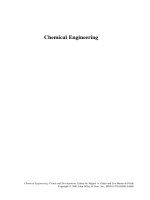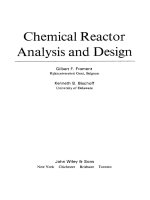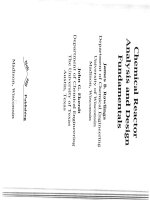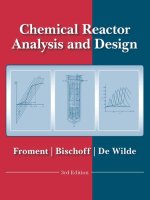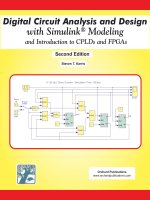chemical reactor analysis and design by gilbert f. froment
Bạn đang xem bản rút gọn của tài liệu. Xem và tải ngay bản đầy đủ của tài liệu tại đây (18.67 MB, 801 trang )
Chemical
Reactor
Analysis
and
Design
Gilbert
F.
Froment
Rijksuniversiteit Gent,
Belgium
Kenneth
B.
Bischoff
University
of
Delaware
John Wiley
8
Sons
New York Chichester Brisbane Toronto
Copyrrght
@
1979
by John Wlley
&
Sons. Inc
All rights reserved. Published simultaneousiy tn Cdna
Reproduction or translatron of any pan of
thrs work beyond that permrtted by Sections
107
and 108 of the
1976
United States Copyright
Act without the
permrssion of the copyrrght
owner is unlawful. Requests for
permtssron
or further tnformation should be addressed to
the
Permrsstons Department. John Wiley
&
Sons.
Library of Congress Cataloging in Publication Data
Frornent. Gilbert
F.
Chemical reactor analysis and design.
Includes index.
1. Chemical reactors.
2.
Chemical reacttons.
3.
Chemical
engineering.
I.
Bischoti. Kenneth
B
joint author.
11.
Title.
Printed in the United States
of America
1098765432
To
our
wives:
Mia
and
Joyce
Preface
This book provides a comprehensive study of chemical reaction engineering,
be-
ginning with the basic definitions and fundamental principles and continuing
a11 the way to practical application. It emphasizes the real-world aspects of chemi-
cal reaction engineering encountered in industrial practice.
A
rational and rigorous
approach, based on mathematical expressions for the physical and chemical
phenomena occurring in reactors, is maintained as far as possible toward useful
solutions. However, the notions of calculus, differential equations, and statistics
required for understanding the material presented in this book do not extend
beyond the usual abilities of present-day chemical engineers. In addition to the
practical aspects, some of the more fundamental, often more abstract, topics
are also discussed
to
permit the reader to understand the current literature.
The book is organized into two main parts: applied or engineering kinetics
and reactor analysis and design. This allows the reader to study the detailed
kinetics in a given "point," or local region first and then extend this to overall
reactor behavior.
Several special features include discussions of chain reactions
(e.g., hydrocarbon
pyrolysis), modem methods of statistical parameter estimation and model dis-
crimination techniques, pore diffusion in complex media, genera1 models for
fluid-solid reactions, catalyst deactivation mechanisms and kinetics, analysis
methods for chemical processing aspects of fluid-fluid reactions. design calcula-
tions for plug flow reactors in realistic typical situations
(e.g., thermal cracking),
fixed bed reactors, fluidized
be'd reactor design, and multiphase reactor design.
Several of these topics are not usually covered in chemical reaction engineering
texts, but are of high current interest in applications.
Comprehensive and detailed examples are presented, most of which utilize
real kinetic data from processes of industrial importance and are based on the
authors' combined research and consulting experience.
We
firmly believe, based on our experience, that this book can
be
taught to
both undergraduate and graduate classes. If a distinction must be made between
undergraduate and graduate material it should be in the extension and the depth
of coverage of the chapters. But we emphasize that to prepare the student to
solve the problems encountered in industry, as well as in advanced research,
the approach must
be
the same for both levels: there is no point in ignoring the
more complicated areas that do not fit into idealized schemes of analysis.
Several chapters of the book have been taught for more than
10 years at the
vii
Rijksuniversiteit Gent, at the University of Maryland, Cornell University, and the
University of Delaware. Some chapters were taught by G.F.F. at the University
of Houston in 1973, at the Centre de Perfectionnement des Industries
Chimiques
at Nancy, France, from 1973 onwards and at the Dow Chemical Company,
Terneuzen, The Netherlands in
1978. K.B.B. used the text in courses taught at
Exxon and Union Carbide and also at the Katholieke Universiteit Leuven,
Belgium, in 1976. Substantial parts were presented
by
both of us at
a
NATO-
sponsored Advanced Study Institute on "Analysis of Fluid-Solidcatalytic Systems"
held at the Laboratorium voor Petrochemische Techniek,
Rijksuniversiteit, Gent,
in August 1974.
We thank the following persons for helpful discussions, ideas, and critiques:
among these are dr. ir.
L.
Hosten, dr. ir.
F.
Dumez, dr. ir.
J.
Lerou, ir.
J.
De
Geyter
and ir.
J.
Beeckman, all from the Laboratorium voor Petrochemische Techniek
of Rijksuniversiteit Gent; Prof. Dan
Luss of the University of Houston and
Professor
W.
D.
Smith of the University of Rochester.
Gilbert
F.
Froment
Kenneth
B.
Biihoff
.
.
.
vlll
PREFACE
Contents
Notation
Greek Symbols
Subscripts
Superscripts
xvii
xxxiii
xxxix
xxxix
Part
One-Chemical Engineering Kinetics
1
Elements of Reaction Kinetics
1
.I
Reaction Rate
1.2
Conversion and Extent of Reaction
1.3
Order
of
Reaction
E,uample 1.3-1 The Rare ofan Autocaralytic Reacrion,
13
1.4
Complex Reactions
Esumple
1.4-1
Comp1e.r Reaction Nertt~orks,
19
E.rattipk
I .J-2
Cu~al~tic Cracking of Gusoil,
24
E.uumple
1.4-3
Rate Determinin,g Step und S~eudv-Sture Appro.uimution,
27
E.uample
1.4-4
Classicul Unimoleculur Rure Theory.
30
E.rample
1.4-5
Thermal Cracking of Efhune,
35
Example
1.4-6
Free Radical Addition Polymeri~ation Kinetics,
38
15
Influence of Temperature
42
E-\ample
1.5-1
Determination of the Actiration Enery?:
43
E.uample
1.5-2
Acticurion Energy for Comp1e.u Reuctions.
44
1.6
Determination of Kinetic Parameters
46
1.6-1
Simple Reactions
46
1.6-2
Complex Reactions
47
E.rump1e
1.6.2-1
Rure Constunr Deiermination
by
file Himmelblau-Jones-
Bischoj'method. 50
Example
1.6.2-2
Olejin Codimerization Kinetics,
53
E.rample
1.6.2-3
Thermal Cracking of Propane,
57
1.7
Thermodynamicaily Nonideal Conditions
60
E.uumple
1.7-1
Reaction of Dilure Strong Electro!vres,
63
E-~umple
1.7-2
Pressure Eficts in Gus-Phase Reactions,
64
2
Kinetics
of
Heterogeneous
Catalytic Reactions
2.1
Introduction
2.2
Rate Equations
Exumple 2.2-1 Cnmpetitir-e Hydrogenation Reocrions.
94
E.xumple 2.2-2 Kinetics of Erhyiene O.ridur~on on a Supporred Silver
Carafvsr,
101
2.3
Model Discrimination and Parameter Estimation
2.3.a Experimental Reactors
2.3.b
The
Differental Method for Kinetic Analysis
2.3.c The Integral Method of Kinetic Analysis
2.3.d Sequential Methods for Optimal Design of Experiments
2.3.d-1 Optimal Sequential Discrimination
Exurnpie 2.3.d.l-i Model Discrimination in rhe Dehydrogeno~ion of
f-Burene inro Buradiene,
121
E.rumple 2.3.d.l-I Ethanol Deh.vdrogenarion. Seqrientiul Discnminarion
Using rhe Inregra! Method of'Kineric Anall~is,
125
2.3.d-2 Sequential Design Procedure for Optimal Parameter Estimation
E.xumple 2.3.d.2-I Sequentiuf Descqn of Experimenrs /or Optimuf Puramerer
Esrimution in n-Penfane Isomeriiur!on. Integral 'Method oJ'Kinrrlc Analysis.
129
3
Transport Processes
with
Fluid-Solid Heterogeneous
Reactions
Part
I
Interfacial Gradient
Effects
3.1
Surface Reaction Between a Solid and
a
Fluid
3.2
Mass and Heat Tramfer
Resistances
3.2.a Mass Transfer Coefficients
3.2.b Heat Transfer Coefficients
3.2.~ Multicomponent Diffusion in a Fluid
E.~umple 3.2.c-1 Use of Mean Efectice Binarv Drffusic~ry,
149
33
Concentration
or
Partial Pressure
and
Temperature Differences Between
Bulk Fluid and Surface
of
a Catalyst
Particle
E.rampfe 3.3-1 Interfaciui Gradienrs rn Erhunol Dehydrogenarion
Expertments,
15
1
Part 11 Intraparticle Gradient
Effects
3.4
Catalyst Internal Structure
35
Pore Diusion
3.5.a Definitions and Experimental Observations
E.rcunpIe
3.5.0-1
Effect of Pore D~jiusion in the Cracking ofdlkanes on
Zeolites,
164
3.5.b General Quantitative Description
of
Pore Diffusion
x
CONTENTS
3.5.c
The Random Pore Model
I
70
3.5.d
The Pdrallrl Cross-Linked Pore Model
172
3.5.5
Pore Diifuslon with Adsorption: Surface Diffuslon: Configurational
Diffusion
1
74
E.rumpie 3.S.e-1 Surface Diff~ision
m
Liquid-FiNed Pores,
175
3.6
Reaction with Pore Diffusion
178
3.6.a Concept of Effectiveness Factor
178
3.6.b
Generalized Effectiveness Factor 182
E.xumple
3.6.6-1
Generuiized Modrclus for First-Order Reversible
Reaction,
185
E.wmpfe
3.6.b-2
Effecrit,eness Facrorsfor Sucrose Inrersion in Ion
E.xchunge Resms.
187
E.wmple
3.6.b-3
Methanol Synthesis,
189
3.6.c
Criteria for Importance of Diffusional Limitations
E.xumple
3.6.c-I
Minimum Distance Ber~veen BiJw1crionuI Cutulr.st
Sites for Absence of Diffusionaf Limtrurions,
192
E.rample
3.6.c-2
Use of Extended Weisz-Prurer Criterion.
196
3.6.d
Combinat~on of External and Internal Diffusion Resistance
197
E.rumple
3.6.d-1
.E.rperimenrul Drferenriution Berbi~een E.~rernul
und
Internu[ Diffirsion Control,
199
3.7
Thermal Effects 200
3.7.a Thermal Gradients Inside Catalyst Pellets
200
3.7.b
External and Internal Temperature Gradients
108
E,~umple 3.7.u-I Temperur~tre Gradients nilh
Catalytic
Reactions,
2 10
3.8
Complex Reactions with Pore Diffusion
214
E.rample
3.8.1
Effect oJCutalyst Purricle Size on Selecrlriiy in Burenr
Dehydrogenution.
2
17
3.9
Reaction with Diffusion in Complicated Pore Structures
22
1
3.9.a Particles
with
Micro- and Macropores
22
1
3.9.b Parallel Cross-Linked Pores 223
3.9s Reaction with Configuritional
Diffusion
224
Example 3.91-1 Cutalyiic Demerallizution (and Desu~urrzarion) o/ Heu0.v
Residium Petroleum Feedsrocks,
225
4
Noncatalytic Gas-Solid Reactions
4.1
A
Qualitative Discunion of Gas-Solid Reactions
4.2
A
General Model
with
Interfacial and Intraparticle Gradients
43
A
Heterogeneow iModel
with
Shrinking Unreacted Core
Example
4.3-1
Combustion of Coke wirhin Porous Catalyst Particles,
252
4.4 Grain
model
Accounting Explicitly for
the
Structure of the Solid
45
Pore Model Acmmting Explicitly for the Structure of the Solid
4.6
Reaction Inside Nonisothermal Particles
4.7
A
Concluding Remark
CONTENTS
xi
5
Catalyst Deactivation
5.1
Types of Catalyst Deactivation
5.2
Kinetics of Catalyst Poisoning
5.2.a Introduction
5.2.b Kinetics of Uniform Poisoning
5.2.c Shell Progressive Poisoning
5.2.d Effect of Shell Progressive Poisoning on the Selectivity of Complex
Reactions
53
Kinetics of Catalyst Deactivation
by
Coking
5.3.a Introduction
5.3.b Kinetics of Coking
5.3.c Influence of Coking on the Selectivity
5.3.d Coking Inside a Catalyst Particle
Example 5.3.d-I Coking in the Dehvdrogenution
of
I-Butene into Butadiene
on a
Chromia-Alumina Cutafvst,
294
5.3.e Determination of the Kinetics of Processes Subject to Coking
Example 5.3.e-I Deh.vdrogenution of I-Burene into Butudiene,
297
6
Gas-Liquid Reactions
6.1
Introduction
6.2
Models for Transfer at a Gas-Liquid Interface
6.3
Two-Film Theory
6.3.a Single Irreversible Reaction with General Kinetics
6.3.b First-Order and Pseudo-First-Order Irreversible Reactions
6.3.c Single. Instantaneous, and Irreversible Reaction
6.3.d Some Remarks on Boundary Conditions and on Utilization and
Enhancement Factors
6.3.e Extension to Reactions with Higher Orders
6.3.f Complex Reactions
6.4
Surface Renewal Theory
6.4.a Single Instantaneous Reaction
6.4.b Single Irreversible (Pseudo) First-Order Reaction
6.4.c Surface Renewal Models with Surface Elements of Limited Thickness
6.5
Experimental Determination of the Kinetics of Gas-Liquid Reactions
Part Two-Analysis and Design of Chemical Reactors
7
The Fundamental Mass, Energy, and Momentum
Balance Equations
7.1
Introduction
7.
l .a The Continuity Equations
7.1.b The Energy Equation
xii
CONTENTS
7.
l
.c
The Momentum Equation
7.2
The Fundamental Equations
7.2.a The Continuity Equations
7.2.b
Simplified Forms of the "General" Continuity Equation
7.2.c The Energy Equation
7.2.d
Simplified Forms of the "General" Energy Equation
8
The Batch Reactor
8.1
The Isothermal Batch Reactor
Exmple 8.1-1 Example of Derivurion of a Kinetic Equation by Means oj
Butch Data,
364
8.2
The Nonisothermal Batch Reactor
Example
8.2-1
Hydrolysis of Acetyluted Cusror Oil Ester,
370
83
Optimal Operation Policies and Control Strategies
8.3.a Optimal Batch Operation Time
Example 8.3.0-1 Optimum Conversion und iWu.~irnum Profit for u
Firs!-Order Reuction,
376
8.3.b Optimal Temperature Policies
E.rumple 8.3.6-1 Optimal Temperarure Trujec!orres for Firsi-Order
Rerrrsible Reucrions,
378
E.uumple
8.3.b-2
Oprimum Temperature Policiestor Conseczrtice und
Purullel Reuct~ons,
383
9
The
Plug
Flow Reactor
9.1
The Continuity, Energy, and Momentum Equations
E.xump1e
9.1-1
Dericurion of u Kineric Equution from E.t-prrimenrs in un
Isoihermul Tubulur Reuctor wiih Plug Flotr,. Thermul Cracking of
Propune.
397
9.2
Kinetic Analysis of Nonisothermal Data
Esumple 9.2-1 Dericarion ofu Rare Equurionfor rhe Thermul Crucking
of
Acerone from Nonisorhermul Dora,
402
93
Design
of
Tubular Reactors with Plug Flow
E.uumple
9.3-1
An Adiubur~c Reuctor with Plug Flow Conditions,
408
E.rumple
9.3-2
Design of
u
Nonisothermai Reucror for Tl~ermoi Cracking
of Ethane,
410
10
The Perfectly Mixed Flow Reactor
10.1
Introduction
10.2
Mass
and Energy Balances
10.2.a Basic Equations
10.2.b Steady-State Reactor Design
E.xumple
IO.2.b-I
Single Irrecersible Reaction in u Srirred Flow Reoctor,
424
CONTENTS
xiii
10.3 Design for Optimum Selectivity in Complex Reactions
10.3.a General Considerations
10.3.b Polymerization Reactions
10.4 Stability of Operation and Transient Behavior
10.4.a Stability
of
Operation
E.rample 10.4.0-I Mulripiicity and Sfabiiity in un Adiabatic Stirred Tunk
Reactor,
446
10.4.b Transient Behavior
Exumple 10.4.b-I Temperalure Osciliariom
in
u Mixed Reactor for
ihe
Vapor Phase Chlormarion
of
Merhyl Chloride,
452
11
Fixed
Bed
Catalytic
Reactors
Part
I
Introduction
1
1.1 The Importance and Scale of Fixed
Bed
Catalytic Processes
11.2 Factors of Progress: Technological Innovations and Increased
Fundamental Insight
11.3 Factors Involved
in
the
Preliminary Design of Fixed
Bed
Reactors
11.4 Modeling of Fixed
Bed
Reactors
Part 11 Pseudo-Homogeneous Models
11.5 The Basic OneDimensional
models
11.5.a Model Equations
E.rumple 11.5.~-
I
Culcu/anon of Pressure Drop m Packed Beds,
48
1
1
1.S.b
Design of a Fixed Bed Reactor According to the One-Dimensional
pseudo-Homogeneous Model
1
1.5.~ Runaway Criteria
E.rump1e 11.5.~-
1
Application ofthe Firsr Runaway Criterion of
Van Wel~rnaere and Fromenr,
490
11.5.d The Multibed Adiabatic Reactor
11.5.e Fixed
Bed
Reactors with Heat Evchange between the Feed and
Effluent or between the Feed and Reacting Gases.
"Autothemic Operation"
I
1.5.f Non-Steady-State Behavior
of
Fixed Bed Catalytic Reactors Due to
Catalyst Deactivation
11.6 One-Dimensional Model with Axial Mixing
11.7 Two-Dimensional Pseudo-Homogeneous Models
1
1.7.a The Effective Transport Concept
11.7.b Continu~ty and Energy Equations
I
I
.7.c Design of a Fixed Bed Reactor for Catalytic Hydrocarbon
Oxidation
Part
111 Heterogeneous Models
11.8
One-Dimensional Model Accounting for Interfacial Gradients
1
f
.8.a
Model Equations
xiv
CON^
11.8.b Simulation of the Transient Behavior of
a
Reactor
549
E.~umple
1
I
.8.b-1
.4
Gus-Solid Reaction in
u
Fixed Bed Reactor,
551
11.9 One-Dimensional
%Idel Accounting for Interfacial and Intraparticle
Gradients
11.9.a Model Equations
Exumple 11.9.~-1 Stmulur ion of u Fuuser-!Monrecaf~ni Reactor for
High-Pressure
Methunoi Synthesis.
562
E.~ample 11.9.~-2 Simulurion of an Industrial Reactor for I-Bu~ene
Dehydrogenation into Butudiene,
571
11.10 Two-Dimensional Heterogeneous
&lodeis
12
Nonideal Flow Patterns and Population Balance Models
592
12.1 Introduction
12.2 Age-Distribution Functions
Example 12.2-1 RTD of a Perfect/y ibfixed Vessel.
595
Example 12.2-2 Determination of RTDfrom Experimenrol Tracer Cur~ve.
596
E,~ampie 12.2-3 Calculutron of Age-Disrriburion Funcrionsfrom
E.rperimento/ Dufa,
598
'
12.3 Interpretation
of
Flow
Patterns from Age-Distribution Fulctions
12.3.a Measures of the Spectrum of Fluid Residence Times
E.rurnple 12.3-1 Aye-Distriburion Func~iom for
a
Series ofn-Stirred Tanks,
603
Exumple 12.3-2 RTDfor Combinations oj~Noninteracting Regions,
605
12.3.b
Detection
of Regions of Fluid Stagnancy from Characteristics of
Age
Distributions
12.4 Application of Age-Distribution Functions
Example
12.4-1
Mean Vulue of'Rute Constant in a Well-Mixed Reactor,
609
E.rumple 12.4-2 Second-Order Reaction in a Stirred Tank.
61
1
Exumple 12.4-3 Reactions in Series Plug Flow and Perfecfly Mired
Reucrors.
61 2
12.5 Flow Models
12.5.a Basic Models
Example 12.5.~-I Axial Dispersion ~Lfodelfor kiminar Flow in Round
Tubes,
620
12.5.b Combined Models
Example 12.5.b-I Transient .Mass Tramfer in a Packed Column,
631
Example 12.5.b-2 Recycle Model for Large-Scale S4ixing Egects,
634
12.5.c Flow
Model
Parameter Estimation
12.6 Population Balance Models
Example 12.6-1 Population Balonce Modei for Micromixing,
646
Example 12.6-2 Surfae Reaction-Induced Changes m Pore-Size
Distribution,
653
13
Fluidized Bed Reactors
13.1
Introduction
13.2
Fluid
Catalytic Cracking
CONTENTS
xv
13.3
Some Features of the Design of Fluidized Bed Reactors
13.4
Modeling of Fluidized
Bed
Reactors
E.~umple 13.4-1 iuodeling of un Acrylonitrile Reactor, 685
14
Multiphase Flow Reactors
14.1
Types
of ~Multiphase Flow Reactors
14.
l .a Packed Columns
14.1
.b
Plate Columns
14.1
.c Empty Columns
14.1
.d Stirred Vessel Reactors
14.1
.e Miscellaneous Reactors
14.2
Design iModels for Multiphase Flow Reactors
14.2.a Gas and Liquid Phase Completely Mixed
14.2.b Gas and Liquid Phase in Plug Flow
14.2.c Gas Phase in Plug Flow. Liquid Phase Completely M~xed
14.2.d
An
Effective Diffusion Model
14.2.e A Two-Zone Model
14.2.f An Alternate Approach
14.3
Specific Design
Aspects
14.3.a Packed Absorbers
E.vumple 14.3.0-1 Design of u Pucked Column for Curbon Dio.ridr
Absorption,
704
E.rumpk 14.3.~-2 Design .4spects of u Pucked Column /or rhc
Absorprion of .4mmoniu in Suljuric
Acid,
708
14.3.
b
Two-phase Fixed Bed Catalytic Reactors with Cocurrent
Downflow. Trickle Bed Reactors and Packed
Downflow Bubble Reactors
14.3.c Two-Phase Fixed Bed Catalytic Reactors with Cocurrent L'pflow.
"Upflow Packed Bubble Reactors"
14.3.d Plate Columns
E.\-ample 14.3.d-1 Gus Absorption wirh Reuction in u Plate Coluner,
722
14.3.e Spray Towers
14.3.f Bubble Reactors
14.3.g Stirred Vessel Reactors
E.rump/e 14.3.g-I Design ofu Liquid-Phase o-Xj.lene Oxidurion Reactor.
A.
Stirred rank reacror.
B.
Bubble
reactor,
732
Acknowledgments
Author Index
Subject Index
xv
i
CONTENTS
Notation
Two consistent sets of &its are listed in the following pages: one that is currently
the most common in engineering calculations (including, for example, m, hr,
atm, kcal) and the
S.I.
units, which are only slowly penetrating into everyday use.
In some formulas other units had to
be
used: the chemical engineering literature
contains many correlations that are not based on dimensionless groups and they
require the quantities to
be
expressed in certain given units only. This has been
carefully indicated in the text, however.
All the numerical calculations in the text are in the above mentioned engineer-
ing units, but the intermediate and final results are also given in
S.I.
units. We
feel that this
reffects-and even simplifies-the practical reality that is going to
last for many more years, and we have preferred
tfiis pragmatic approach to
preserve the feeling for orders of magnitude gained from years of manipulation
of
the engineering units. Finally, great attention has been given to the detailed
definition of the units of the different quantities: for example, when a dimension
of
length is used, it is always clarified
as
to whether this length concerns the catalyst
or the reactor. We have found that this greatly promotes insight into the mathe-
matical modeling of a phenomenon.
Engineering
units
S.I.
units
A
reaction component
A
b
heat exchange surface, m2 m2
packed bed side
A,
reacting species in a
reaction system
A,
heat exchange surface in a mZ m2
batch reactor, on the side of
the reaction mixture
Am
logarithmic mean of
A,
and m2 m
A,
or of
Ab
and
A,
A,
heat exchange surface for a mz
m2
batch reactor on the side of
the heat transfer medium
'4,
total heat exchange surface m2
m2
xvii
Engineer~ng
units
S.I.
unlts
c,.
c,,
c,
C.4br
C8b
.
.
.
heat exchange surface for
a
packed
bed
on the side of
the heat transfer medium
gas-liquid interfacial area
per unit liquid volume
interfacial area per unit tray
surface
frequency factor
absorption factor,
L'!mF
gas-liquid interfac~al area
per
unlt gas
+
liquid volume
stoichiometric coefficient
parameters
(Sec. 8.3.b)
surface to volume ratio of a
particle
external particle surface
area per unit catalyst mass
external particle surface
area per unit reactor
volume
order of
reactlon with
respect to
A
order
of
reaction with
respect to
'4,
gas-liquid interfacial area
per unit packed volume
liquid-solid interfacial area
per unit packed volume
reaction component
fictitious component
vector
of
fictitious
components
stoichiometric coefficient
order of reaction with
respect to
B
molar concentration of
species
A.
B,
j
molar concentrations of
species
A.
B
. . . in the bulk
fluid
molar concentrations of
adsorbed
A,
B
.
.
.
drag coefficient for spheres
mpl:mp3
mp2,'mp3
mPZ'kg
cat.
mP2;kg cat.
m,z!m,' mpZ
mp3
kmol/m3
kmolirn,'
kmol,kg
cat.
kmolikg cat.
xviii
-
NOTATION
S.I.
units
molar concentration of
reacting component
S
of
solid
coke content of catalyst
molar concentration of
vacant active sites of
kg cokelkg cat.
kmolikg cat.
kg cokeikg cat.
kmolikg cat.
catalyst
total molar concentration
kmolllg cat. kmolikg cat.
of active sites
inlet concentration
vector of concentrations
molar concentration of
d
at
eqcilibrium
molar concentration of
.4
in
front of the interface
molar concentration of
fluid
ieactanc inside the
solid
molar concentration of
sorbed poison inside
catalyst, with respect to
core boundary
equilibrium molar
concentration of sorbed
poison inside catalyst
reactanr molar
concentration at centerline
of particle (Chapter
3)
Laplace transform of
C,
molar concentration of
fluid reactant in front of
the
solid surface
molar concentration of
A
inside completely
reacted zone of solid
specific heat
of
fluid
specific heat of solid
Damkahler number for
poisoning,
k,,
RID.,
molecular diffusivities of
A,
B
in liquid
film
molecular diffusivity for
A
in
a binary mixture of
A
and
B
xix
NOTATION
stirrer diameter
internal tube diameter also
tower diameter (Chapter
14)
activation energy
Murphree tray efficiency
corrected for entrainment
exponential integral
Murphree tray efficiency
overall tray efficiency
point tray efficiency along
gas streamline
Eotvos number. based on
d*p,g
bubble diameter,
-
u
error function
complementary error
function,
I-err(?)
total molar flow rate
enhancement factor
molar feed rate of reactants
A
and
j
force exerted per unit
cross section
objective function
volumetr~c gas flow rate
volumetr~c gas feed rate
volumetric gas flow rate
(Chapter
14)
friction factor in Fanning
equation
fraction of total fluidized
bed volume occupied by
bubble gas
fraction of total fluidized
bed volume occupied by
emulsion gas
superficial mass flow
velocity
matrix of partial derivatives
of model with respect to the
parameters
transpose
of
G
Engineering
units
S.I.
units
NOTATION
xx
i
Engineering
units
S.I.
units
acceleration of gravity
external force on species
j
in
the
1
direction per unit
mass of
j
partial derivative of
reaction rate with respect to
the parameter
K,
at the uth
set of experimental
conditions
Henry's law coefficient
enthalpy of gas on plate
n
liquid height
enthalpy of liquid on
plate
n
heat of format~on of species
j
height of stirrer above
bottom
molar enthalpy of species
j
heat of reaction
heat transfer coefficient for
film surrounding
a
particle
initiator; also intermediate
species: inert;
unit matrix
molar
flux
of species
j
in
1
direction, with respect to
mass average velocity
pressure drop in straight
tubes
j-factor for mass transfer,
j-factor for heat transfer,
equilibrium constants
matrix of rate coefficients
kinetic energy
per
unit mass
flow averaged kinetic
energy per unit mass
reaction rate coefficient
xxii
kcalikmol
kcal/kmol
kcal/m: hr
"C
Nmikmol
kJ;kmol
m
kJ/kmoi
kJ/kmol
m
kJ;kmol
kJ, kmol
kJ,'mPz
s
K
kmol/m2 hr kmol/m2
s
kgf;mZ or atm
N!m2
see
k:.
k,,
kp
NOTATION
Engineering
units
S.1.
units
k
rate coefficient with respect
to unit solid mass for a
reaction with order
n
with
respect to fluid reactant A
and order
m
with respect to
solid component
S
coking rate coefficient
gas phase mass transfer
coefficient referred to unit
interfacial area
liquid phase mass transfer
coefficient referred to unit
inierfacial area
mass transfer coefficient
(including interfacial area)
between flowing and
stagnant liquid in
a
multiphase reactor
ki-I,
k72
mass transfer coefficient
(including interfacial area)
beween regions
I
and
2
of
flow model (Chapter
12)
kc
rate coefficient based on
concentrations
kg
gas
phase mass transfer
coefficient; when based on
concentrations; when based
on mole fractions
;
when
based
on partial pressures;
in a fluidized bed
interfacial
mass transfer
coeficient for catalyst
poison
mass transfer coefficient
between liquid and catalyst
surface, referred to unit
interfacial area
kp reaction rate coefficient
based on partial pressures
kw
rate coefficient for
propagation reaction in
addition polymerization
NOTATION
mf3"(kmol A)'-" mf3"(krnol
.A)'
-"
(kmol
S)-"
(krnol
s)-"
m:'"-
"
hr-
mP3(m-
"s"
kg cokeikg cat. hr
kg
coke!kg cat
atm or
hr-' s(N;m2) or
s-
'
mG3 m: hr ~n~'/.m,~ s
hr- '(kmoli s-'(kmolf
m3',1-ta
+b' l
m3;
I
-W-W
j
m,3/mp' hr; mfJ, rn;
S;
kmol/mp2 hr: kmol!mP2 s;
kmol/mpz hr atm kmollmpL s (Nim');
mf3;m,%r
m
/','m,"
s
xxiii
Engineering
units
S.I.
units
k,
k,~,
k,e
krp
k,
k,.
kt,
k,.
kE
k,
li.,
k,.
k2 .
k;
k
;
k
;
k
;
(k6c)b
(kdb
reaction rate coefficient
(Chapter
3)
rate coefficient for catalytic
reaction subject to
poisoning
rate coefficient for
first-order poisoning
reaction at core boundary
surface-based rate
coefficient for catalytic
reaction (Chapter
5)
rate coefficients for
termination reactions
volume-based rate
coefficient for catalytic
reaction during poisoning,
resp. in absence of poison
rate coefficient based on
mole fractions
slutriation rate coefficient
(Chapter
13)
reaction rate coefficients
rate coefficient of catalytic
reaction in absence of coke
mass transfer coefficient in
case of equirnolar
counterdiKusion, k,yJl
mass transfer coefficient
between stagnant liquid
and catalyst surface in a
multiphase reactor
surface based reaction rate
coefficient for gas-solid
reaction
mass transfer-coefficient
from bubble to interchange
zone. referred to unit
bubble volume
overall mass transfer
coefficient from bubble to
emulsion, referred to unit
bubble volume
m,'/m2 cat. hr
mJ3!m2 cat. s
ml J,'m2 cat. hr m,'/mz cat. s
m13/m2 cat. hr m13/mZ cat. s
m131m2 cat. hr
mf3.!m2 cat. s
m3/kmol hr or hr-
'
mJ/kmol s or
s-'
mJ3/m3 cat. hr
m,31m3 cat. s
see
k,,
k,.
k,
depending on rate
dimensions
see
k,
kmol
A
m13/mb3 hr mJ3/m,' s
xxiv
NOTATIO~
Engineering
units
S.I.
units
(kce)b
mass transfer coeficient
from interchange zone to
emulsion, referred to unit
bubble volume
(ktA
mass transfer coefficient
from bubble
+
interchange.
zone to
emulsion, referred
to unit bubble
+
interchange zone volume
L
volumetric liquid flow rate
also distance from center to
surface of catalyst pellet
(Chapter
3)
also distance between pores
in
a solid particle
(Sec.
4.5)
and thickness of a slab
(Sec. 4.6)
total height of fluidized bed
height of a fluidized bed at
minimum fluidization
molar liquid flow rate
modified Lewis number.
.I,./P,c,,
D,
vacant active site
ratio of initial
concentrations
CewiC,,
molecular weight of
species
j
mean molecular weight
monomer
(Sec.
1.4-6)
Henry's coefficient based on
mole fractions. also order
of reaction
mt
total mass
m
total mass flow rate
mi
mass flow rate of
component
j
N
stirrer revolution speed;
also runaway number,
2ff/R,pc,k,
(Sec. 11.5.~)
'VA
molar rate of absorption
per unit gas-liquid
interfacial area
kgi
kmol
kg/kmoi
NOTATION
xx
Engineering
units
S.I.
units
N,,,
NB,
N,
PA~Ps-P~
Par
also molar flux of
A
with
respect to fixed coordinates
instantaneous molar
absorption rate in element
of age
t
per unit gas-liquid
interfacial area
number of kmoles of
reacting components
A,
B,
j
.
.
.
in reactor
dimensionless group,
total number of kmoles in
reactor
minimum stirrer speed for
efficient dispersion
characteristic speed for
bubble aspiration and
dispers~on
order of reaction
reaction product
also power input (Chapter
14)
Prandtl number,
c,dl
profit over
N
adiabatic
fixed beds
active polymer
Peclet number based on
particle diameter,
uiddD,.
Peclet number based on
reactor length,
uiL/D,.
number averaged degree of
polymerization
weightaveraged degree of
polymerization
probabilty of adding
another monomer unit to
a
chain
partial pressures of
components
A,
5,
j
.
.
.
partial pressure of acetone
(Chapter 9)
kmol kmol
kmol
hr-'
hr-I
atm
atm
kmol
s-I
s-I
Nm,
s
s/s
xxvi
NOTATIC
Eng~neering
units S.1. units
critical pressure
film pressure factor
total pressure
reaction component
heats of oxidation,
adsorption, absorption
stoichiometric coefficient;
also heat flux
order of reaction
wirh
respect to
Q
order of reaction with
respect to
Aj
gas constant
also radius of a spherical
panicle (Chapters
4
and
5)
also reaction component
Reynolds number,
d,G/p
or
d,
G/p
total rate of change of the
amount of component
j
pore radius in pore model
of
Szekely and Evans
(Sec.
4.5)
tube radius
free radicals
rate of reaction per unit
volume
also pore radius (Chapter
3)
also radial position in
spherical particle
(Chaper
4)
also stoichiometric
coefficient
rate of reaction
of
component
A
per
unit
volume
or
per unit catalyst mass
rate of coke deposition
rate of poison deposition
rate of reaction of
S,
reactive component
of
solid, in gas-solid reactions
atrn
N(m2
atm N;mZ
atm N/mZ
kca1,'kmol kJ/'kmol
kcal/mZ hr
kJ/m2s or kWim2
kcal/kmol
K
or klikrnol
K
atm m3/kmol
K
m
kmol/kg
cat.
hr
kmol,&g.
cat.
s
kg
cokekg cat.
hr
kg cokehg cat. s
kmol/kg cat. hr
kmol/kg cat.
s
kmolkg solid hr
kmolhg solid s
NOTATION
xxvii
Engineering
units
S.I. units
Sh'
rate of reaction of
A
at
interface
radius of bend of coil
radial position of
unpoisoned or unreacted
core in a sphere
reaction rate per unit pellet
volume
mean pore radius
reaction component
also dimensionless group,
fi
(Chapter 11)
Schmidt number,
p/pD
internal surface area per
unit mass of catalyst
external surface area of
a
pellet
modified Sherwood number
for liquid film.
kuA,.D,,
modified Sherwood
number,
k,
L,
D,
(Chapter
3)
modified Sherwood number
for poisoning,
k,,R:D,,
stoichiometric coefficient
also parameter in
Danckwerts' age
distribution function
also
Laplace transform
variable
experimental error variance
of model
i
order of reaction with
respect to
S
pooled estimate of variance
temperature
bed
temperature at radius
R,
critical temperature
maximum temperature
temperature of surroundings
temperature
instde solid,
resp. at solid surface
m2cat.,'kg cat. m'cat., kg cat.
m2 m
'
xxviii
NOTATION


